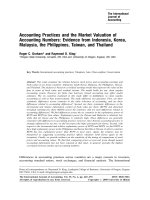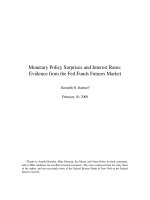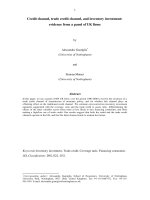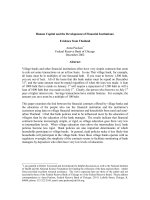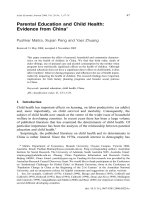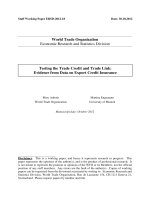Credit Market Development and Firm Innovation: Evidence from China
Bạn đang xem bản rút gọn của tài liệu. Xem và tải ngay bản đầy đủ của tài liệu tại đây (884.52 KB, 23 trang )
<span class='text_page_counter'>(1)</span><div class='page_container' data-page=1>
1
<b>Credit Market Development and Firm </b>
<b>Innovation: Evidence from China </b>
Abstract
From the perspective of credit allocation, this paper analyzes the effect of credit
market development on firms’ innovative capacities in China. Using a large data set of
Chinese industrial firms in 31 provinces, we find out that, from the credit allocation
perspective, credit market development enhances both firms’ innovation incentives
and outcomes. We show that firms’ credit constraints and firms’ performances are two
channels through which the credit market development affects firms’ innovative
capacities. The innovation incentives and outcomes of more credit restrained firms
and firms with better performances are affected by credit market development more
than those of other firms. In addition, we demonstrate that our results are not driven
by the increase of the number of firms.
</div>
<span class='text_page_counter'>(2)</span><div class='page_container' data-page=2>
2
1 Introduction
Innovation, as the engine of a firm’s development, has been taken as a major driving
force of economic growth since Solow (1957). However, what drives innovation is still
worth investigating. There is a growing literature exploring the factors affecting
innovation from various perspectives. In this paper, we contribute to this literature by
analyzing how the development of the credit market affects firm innovation, from the
perspective of credit resource allocation.
As Levine (2005) pointed out that “…, if finance is to explain economic growth, we
need theories that describe how financial development influences resource allocation
decisions in ways that foster productivity growth…” It indicates that if credit market
development helps allocate more credit to firms or projects that increase productivity
growth, credit market development is expected to increase innovation. In other words,
if the financial intermediaries are active in researching firms, monitoring firms and
pooling risks, they are supposed to enhance firms’ innovative capacities.
In order to measure the credit allocation induced by credit market development, we
use an index constructed from the ratio of credits allocated to non-state-owned
enterprises (non-SOEs) on total credits of each province in China. King and Levine
(1993) argue that a financial system which simply allocates credits to state-owned
enterprises (SOEs) is different from that allocating to private firms. By allocating to
SOEs, the financial intermediaries usually just follow the government directives
without exerting its function to facilitate credit allocation. On the contrary, allocating
to non-SOEs could indicate that financial institutions actively examine firms’
performances.
China provides a good case study for analyzing whether credit market development,
from the perspective of credit allocation, affect firms’ innovative capacities. The
Chinese credit system originates from a mono-bank system, with the People’s Bank of
China (PBC) functioning both as a central bank and a commercial bank. It is evolving
towards a more market-based system gradually. Until now, the credit system is
composed of various types of banks and non-bank financial institutions to satisfy
different kinds of firms. The credit allocation also turns from policy lending to more
market-based lending. As Firth et al (2009) show that the Chinese banks have already
been able to use commercial judgments to allocate credits to private firms to some
extent.
</div>
<span class='text_page_counter'>(3)</span><div class='page_container' data-page=3>
3
innovative behavior of the non-listed firms. More than 99% of the firms in this data set
are non-listed. Since the non-listed firms are accounted for a much larger part of the
Chinese economy, it is very important to explore factors affecting non-listed firms’
innovative capacities. Further, compared to listed firms, non-listed firms rely more on
credit financing for their operations. The second advantage of this data set is that
banks apply commercial judgments to a larger degree for the manufacturing industry
(Firth et al, 2009).
One of the important problems in the finance-innovation literature is the endogeneity
problem caused by omitted variables and the reverse causality of finance and
innovation. We minimize the omitted variable problem by using firm-level analysis.
Firm-level analysis allows us to control many unobserved variables, such as firm-level,
industry-level and province-level unobserved variables which might affect both credit
market development and firm innovation. We then apply instrumental variable
method to solve the reverse causality problem.
Our results indicate that, from the credit allocation perspective, credit market
development enhances both firms’ innovation incentives and outcomes. We further
demonstrate that there are two possible channels. One channel is through relaxing
firms’ credit constraints. The marginal benefit of the credit market development on
the credit restrained firms are larger than that on other firms. The innovation
incentives and outcomes of more credit restrained firms, such as private firms and
small- and middle-sized firms (SMEs), are affected by credit market development more
than those of other types of firms. Another channel is that by improving credit
allocation, financial institutions are more willing to lend to firms with better
performances. Therefore, the innovation incentives and outcomes of firms with better
performances are affected by credit market development more than those of firms
with worse performances. In addition, we demonstrated that our results are driven by
improvement of credit allocation rather than increase of number of non-SOEs in a
province. Our results are also robust to different estimation methods and different
sample.
</div>
<span class='text_page_counter'>(4)</span><div class='page_container' data-page=4>
4
recent cross-country and within country empirical analysis also reaches contrary
conclusions. For example, Ayyagari, et al. (2011) find that bank financing enhances
innovation of SMEs in developing countries. Xiao and Zhao (2012) argue that credit
market development enhances innovation for countries with lower government
ownership of banks. Hsu, et al (2014) find that credit market development discourages
innovation for more high-tech intensive industries and industries more dependent on
external finance. Benfratello, et al. (2008) argue that for Italian firms, banking
development accelerates the probability of process innovation, but less for product
innovation. Daniele, et al. (2013) find that for US listed firms in 1976 to 1995, credit
market development enhances the quantity and quality of innovation activities.
Different from researches which provide country-level and industry-level researches,
we provide firm-level evidences for the debate on whether and how credit market
development affects innovation. We also discuss the underlying mechanisms. In
addition, our results shed light on the debate on whether financial development
affects economic growth.
The rest of the paper is organized as follows. In Section 2, we provide institutional
background. Section 3 describes data and provides summary statistics. Section 4
presents results. Section 5 provides robustness check. Section 6 concludes.
2. Institutional Background
After several years of development, the Chinese financial system is gradually going
towards a more efficient and effective system. The credit resources allocation also
becomes more market-based.
Before 1978, the Chinese financial system was a mono-bank system. The People’s
bank of China (PBC), functioned both as a central bank and a commercial bank. From
1978 to 1984, four state-owned specialized banks were established. The credit
business was separated from PBC to the four banks. However, even there were many
new institutions created, the financial system did not change much in its style of
operation. The four banks just supplied loans to state-owned enterprises based on
policy lending.
</div>
<span class='text_page_counter'>(5)</span><div class='page_container' data-page=5>
5
style are more market-based than the four specialized commercial banks. In 1994,
three policy banks were founded, separating the policy businesses from the four
specialized banks. The four specialized banks gradually became state-owned
commercial banks. From 1996, the rural credit cooperatives are separated from
Agriculture Bank of China.
The PBC also took some reforms on commercial banks’ lending behavior in 1998. It
abolished the loan size restrictions on the four state-owned commercial banks. The
management style changed from mandatory plans to guiding plans. It also asked all
commercial banks to rank their loans into five categories according to loan risk from
1998 to 2000.
After the entry of WTO in 2001, the Chinese financial system further went through
several reforms. In 2002, China Union Pay was set up, bank card could be used across
banks and regions. It greatly improved the information processing speed of the
financial system. In 2003, the Chinese banking regulatory commission (CBRC) was
established. The Chinese government tried to reinforce the PBC’s independence in
monetary policy. In order to improve the corporate governance of the four
state-owned banks, and speed up the commercialization of the state-state-owned banks, the
government allowed four state-owned banks to go public from 2005 to 2008. In
2004, the CBRC also expressed its opinion to encourage and support city commercial
banks to bring in foreign strategic investor, go public and reconstruct. CBRC further
allowed these banks to operate across regions gradually. In 2006, the government
opened the RMB business completely to foreign banks. The entry of foreign banks
had contributed to the efficiency of the Chinese banking system (Xu, 2011).
In the meantime, Chinese financial intermediaries were guided to extend more credit
to SMEs and private firms. According to the speak of the Chinese vice prime minister,
Bangguo, Wu, in the 2001 APEC SME supervisor ministering meeting, the number of
SMEs is around 99% of total number of enterprises in China; industrial output to total
output is around 60%; the employee number is around 75% of total number of urban
employees. The Minister of All-China Federation of Industry and Commerce (ACFIC)
Ministry of Economy Affairs, Xiaoming Ouyang, in the 2007 National development
and reform commission (NDRC) press conference said 90% of SMEs were private
enterprises.
</div>
<span class='text_page_counter'>(6)</span><div class='page_container' data-page=6>
6
because they were lacking of knowledge and skills to identify promising SMEs. CBRC
had invited some small financial institutions and city commercial banks which had
good experiences in supporting SMEs to introduce their experiences.
3. Data and Summary Statistics
3.1 Innovation measure
We construct two innovation measures from the value of new products and total
products. One is firms’ innovation incentives, NP, a dummy variable.
NP𝑖,𝑡= {<sub>0 𝑖𝑓 𝑓𝑖𝑟𝑚 𝑖 𝑑𝑜𝑒𝑠𝑛</sub>′<sub>𝑡 𝑝𝑟𝑜𝑑𝑢𝑐𝑒 𝑛𝑒𝑤 𝑝𝑟𝑜𝑑𝑢𝑐𝑡 𝑖𝑛 𝑦𝑒𝑎𝑟 𝑡 </sub>
1 𝑖𝑓 𝑓𝑖𝑟𝑚 𝑖 𝑝𝑟𝑜𝑑𝑢𝑐𝑒 𝑛𝑒𝑤 𝑝𝑟𝑜𝑑𝑢𝑐𝑡 𝑖𝑛 𝑦𝑒𝑎𝑟 𝑡
, 𝑓𝑜𝑟 𝑖 = 1, … 𝑁; 𝑡 = 2000, … 2007
However, this can only measure whether a firm would like to engage in innovative
activities. It can not differentiate firms with more innovative activities from those
having less innovative activities. Therefore, the second measure we construct is called
innovation outcome, NPr. It is measured as the ratio of the new product production of
a firm in one year on its total production in that year. The higher the NPr, the more
innovative the firm is in a particular year.
Panel A of Table 1 provides the summary statistics for NP and NPr in the full sample
and for innovative companies only. The sample sizes for the full sample and the
innovation companies are 891462 and 127959, respectively.The mean and standard
deviation of NP is 0.067 and 0.250. The mean and standard deviation of NPr are 0.03
and 0.139. The medians for both NP and NPr are 0. It indicates that there are many
zeros in the data. For the sample including innovative companies only, the mean and
standard deviation of NP are 0.4 and 0.490, respectively. The mean and standard
deviation of NPr are 0.19 and 0.303, respectively. The median becomes 0.021.
3.2 financial development measures
We use an index constructed from ratio of credits allocated to non-SOEs on total
credits for 31 provinces as the measure of credit market development. This indicator
is designed to assess how the credits are allocated among firms. As King and Levine
(1993) argues that a financial system, which allocates more financial resources to
private firms are more active in researching firms, managing risks, than that only
allocating financial resources to SOEs. Therefore, a higher value of this index
indicates that the credit allocation by the financial institutions are more active in
researching firms rather than government policy oriented.
Panel C and Panel D of Table 1 present the mean of the credit market development
index in various years and various provinces. Since we lag the credit market
</div>
<span class='text_page_counter'>(7)</span><div class='page_container' data-page=7>
7
allocation throughout these years. The credit market development of different
provinces vary a lot. The lowest and highest credit market development are only 1.9
and 10.82 on average. Jiangsu, Zhejiang and Fujian provinces rank the top three of
the credit market development on average. Jilin, Heilongjiang and Hubei rank the
bottom three. Surprisingly, the credit market in Beijing doesn’t rank very high. It is
probably because the Beijing is the capital city. The financial institutions in Beijing are
affected by the central government more than many other provinces.
3.3 Control variables
Following the literature, we include firm, industry and province control variables which
might affect firm innovation. The firm control variables include firm size, firm age, age
square, leverage, investment intensity, whether it is an export firm, roa, ownership
types. Industry control variable includes industry concentration (hhi). Province control
variables include secondary industry production ratio, third industry production ratio
and provincial GDP per capita. In addition, we include the government subsidy since
the Chinese government subsidies the companies in order for them to engage in more
innovative activities.
4. Results
4.1 Baseline results
We investigate how credit market development by improving credit allocation,
affects innovation from two perspectives. First, we explore whether the improving of
the allocation affects firm incentives to produce new product in general. Second, we
investigate whether the improvement of the allocation encourage firms to produce
more products.
Table 2 provides the results for both firms’ innovation incentives and innovation
outcomes. For the innovation incentives, we apply both pooled logit and conditional
logit estimation methods. The advantage of the pooled logit is that it can utilize the
information in all observations. It can also provide average partial effect of a variable.
In comparison with the pooled logit method, the advantage of the conditional logit is
that besides unobserved industry and province fixed effects, it also allow us to
control unobserved firm fixed effect. In other words, it can include many
time-invariant firm characteristics which affect both credit market development and firms’
innovation incentives. This reduces the endogeneity problems caused by omitted
variables. Nevertheless, the conditional logit method sacrifices the average partial
effect and the sample size. The standard errors are clustered by industry and
province.
</div>
<span class='text_page_counter'>(8)</span><div class='page_container' data-page=8>
8
shows that credit market development, through improving of credit allocation,
enhances the probability of firms producing new products in a statistically significant
way, at 1% level, holding other factors constant. When the credit market
development increases by 1 point, it induces around 471 (891384/7*0.0037) firms to
engage in producing new products in one year, on average. Column (2) provides the
results under the conditional logit method. The credit market development is also
significantly positive at 1% significance level. All the results confirm the idea that the
credit market development, by improving credit allocation, does increase firms’
innovation incentives.
The results also indicate that firm size, the ratio of firms’ export on production, firms’
performances, GDP per capital in a province and the proportion of third industry
production on GDP have statistically positive effects on firms’ incentives in engaging
in innovative activities. On the contrary, firms’ leverage and the proportion of
secondary industry production on GDP in a province have statistically negative effects
on firms’ innovation incentives. In addition, as firms’ grow older, their innovation
incentives first decrease and then increase.
For firms’ innovation outcomes, the estimation methods we use include both fixed
effect regression method and Tobit method. The fixed effect regression method is a
commonly used method and very easy to apply. It can help reduce the endogeneity
problem caused by omitted variables. However, it cannot account for the fact that
the data are censored. Since not all firms produce new product each year, there are
many zeroes in the data, which might make the fixed effect regression to be less
trustworthy. In comparison with the fixed effect regression method, the Tobit
method is more suitable to the censored data. The standard errors are also clustered
at province and industry level.
The results for firms’ innovation outcomes are presented in column (3) and (4) in
Table 2. In column (3), we provide the results estimated by the fixed effect regression
method. The results in column (3) show that the coefficient on credit market
development is positive and significant at 5% level. When credit market development
increases by 1 point, a firm produces 33 RMB (66739.79*0.05%)1 more new
products in one year on average. The results estimated by the Tobit method are
presented in column (4). The coefficient on credit market development is positive
and significant at 1% level. After accounts for the fact that the data are censored, the
coefficient of credit market development on firms’ innovation outcomes increases a
lot. It shows that when credit market development increases by 1 point, a firm is
predicted to produce 1441 RMB (66739.79*2.16%) more new products in one year,
on average. All the results in Table 2 reinforces the idea that the credit market
development, by improving credit allocation in China, does promote industrial firm
innovation.
</div>
<span class='text_page_counter'>(9)</span><div class='page_container' data-page=9>
9
4.3 Mechanisms
In this subsection, we investigate the mechanisms through which the credit market
development, through improving credit allocation, affects firm innovation incentives
and outcomes. Specifically, we examine the credit constraint channel and the firm
performance channel.
4.3.1 Credit constraint
We first examine how the credit market development promotes firms’ innovation
incentives and outcomes through alleviating firms’ credit constraints. We hypothesis
that if financial intermediaries can effectively alleviate firms’ credit constraints
through time, more credit restrained firms should be affected by credit market
development more. It is because the marginal utility provided by credit market
development is higher for more credit restrained firms than less restrained firms.
In order to examine whether the more credit restrained firms are affected by credit
market development more, we first test whether private firms are affected by credit
market development more than other types of firms. The private firms have been
found to be discriminated by Chinese banks due to several reasons. Firstly, the
Chinese financial system originated from a state-owned mono-bank system. The
financial institutions tend to allocate credits following central government or local
governments’ directives (Cull and Xu, 2003). Secondly, due to the short-credit history
and non-standard financial reports, the financial institutions discriminate non-listed
private firms (Brandt and Li, 2003, Guariglia and Poncet, 2008). However, realizing
the importance of the private sector on economic development2<sub> and their problems </sub>
in shortage of credit support, the Chinese government exert several methods to help
the private sector. It includes stating that the private firms are an important
component in the Chinese economy, protecting private properties by law and
reforming banks to meet private firms’ credit requests. As time goes on, the situation
for private firms is improving slowly. The data from Almanac of China’s Finance and
Banking indicates that in 2000, the percentage of short-term loans to private firms is
1%. It increases to 3% in 2007.
We construct a dummy variable, private, where private equals one if the firm is a
private firm and zero otherwise. We then add the interaction of private and credit
market development to the models in Section 4.1. The coefficient of the interaction
term captures the effect of the credit market development on private firms’
innovative capacities compared to those of the SOEs. In Table 3, we provide the
results for both firms’ innovation incentives and outcomes. Column (1) and (2) show
the results for firm innovation incentives under logit and conditional logit methods.
The coefficients on the interaction of the credit market development and private are
2<sub> From the Chinese NBS survey for the industrial firms, in 2000, the private sector contributes to 6% of gross </sub>
</div>
<span class='text_page_counter'>(10)</span><div class='page_container' data-page=10>
10
positive and significant at 5% significance level in both regressions. It means that the
credit market development enhances innovation incentives of the private firms more
than those of other types of firms. Compared to other types of firms, the effect of
credit market development on private firms’ innovation incentives is 0.12% higher.
Column (3) and (4) present the results for firms’ innovation outcomes. The
coefficients on the interaction of the credit market development and private are also
positive and significant at 5% significance levels. Compared to other types of firms,
the effect of credit market development on private firms’ innovation outcomes is
0.09% higher under fixed effect regression and 0.59% higher under Tobit method.
We then test whether the small- and middle-sized firms (SMEs) are affected by credit
market development, through improving of credit allocation, more than large firms.
It has been documented that compared to large firms, SMEs are less able to obtain
credit from banks (Beck et al, 2008; Chong et al, 2013). The Chinese government has
executed many methods to resolve this problem including modifying banking
structures and directing banks to lend to SMEs. However, the problem hasn’t been
fully resolved yet (Chong et al, 2013).
We construct two dummy variables: middle and small. Middle equals one if the size
of the firm is middle and zero otherwise. Small equals one if the size of the firm is
small and zero otherwise. We add small dummy, middle dummy, interaction of the
small dummy and credit market development, and interaction of middle-dummy and
credit market development to the models in Section 4.1. The results are presented in
Table 4. All coefficients of the interaction terms in Column (1) and (2) are positive
and significant at 1% level. The results indicate that compared to large firms, the
credit market development affects SMEs’ innovation incentives by 0.63%
(0.4%+0.23%) more. Both coefficients of the interaction terms are also significantly
positive at 5% level under Tobit method. It shows that compared to large firms, the
effect of credit market development on SMEs are 3.14% higher.
All the results in Table 3 and Table 4 show that credit constraint is an underlying
mechanism which explains how the credit market development promotes firm
innovation. The credit market development by improving credit allocation
encourages credit restrained firms to innovate more than it does to less credit
restrained firms.
4.2.2 Firm performances
</div>
<span class='text_page_counter'>(11)</span><div class='page_container' data-page=11>
11
ability to pay back loans on time. Second, firms which have better performances
might indicate that the operation, management and the strategy of the firms are
better than other types of firms and they might care more about their long-term
growth. Third, with better performances, firms might have greater ability and more
willing to engage in risky innovative projects. Therefore, banks might be also more
willing to lend to the innovative projects of firms with better performances than
those with worse performances.
We use return on asset (roa) as a proxy for firm performance. The higher the roa, the
better the firm performance. Table 2 also shows that firms’ roa has a positive and
significant effect on firms’ innovation incentives and outcomes. We generate a
dummy variable fp50. In order to construct this variable, we first sort the firms based
on their roas among the same industry, province and year. Fp50 equals 1 if the firms’
performances are in the higher 50 percentile, and zero otherwise. The fp50 and the
interaction term of fp50 and credit market development are added to all the models
in Section 4.1. A positive and significant interaction term indicates that the firm
performance is indeed a channel.
In Table 5, we present our results. Column (1) and (2) show the results for firms’
innovation incentives, estimated by logit and conditional logit methods, respectively.
Column (3) and (4) show the results for firms’ innovation outcomes, estimated by
fixed effect regression method and tobit method. The coefficients associated with
the interaction terms of credit market development and fp50 are all positively
significant at 5% level. It indicates that compared to low-performance firms, the
effect of credit market development on high-performance firms’ innovation
incentives and outcomes are 0.09% higher, 0.04% higher under fixed effect
regression and 0.48% higher under tobit method, respectively.
5 Robust Check
In this section, we check the robustness of our results. We first check the validity of
our results using instrumental variable method. We then examine whether our
results are driven by increase of the number of non-SOE firms rather than
improvement of credit allocation. In the end, we evaluate our results using firms
which produce new products only.
5.1 Instrumental variable regression
In this subsection, we solve the reverse causality problem using instrumental variable
method. We construct an instrumental variable as follows. We use the average of the
credit market development in neighboring provinces as the IV. Since the logit
</div>
<span class='text_page_counter'>(12)</span><div class='page_container' data-page=12>
12
probit and IV-probit methods.3<sub> The results are quite similar. The results are available </sub>
upon request.
Table 6 presents the results. Column (1) provides the results using the fixed effect
regression method. Column (2) shows the results using the Tobit method. The
coefficients obtained by these two methods are all statistically significant at 1%
significance level. It further reinforces the idea that credit market development, by
improving credit allocation, promotes firm innovation.
5.2 Improvement of credit allocation or not?
Since the credit market development variable is constructed as an index of credits to
non-SOEs on total credits, the larger the number of non-SOEs might lead to the
higher the value. It indicates that the increase of the credit market development
might not be due to the improvement of the credit allocation. Instead, it is because
of the increase of the number of non-SOEs. In order to check whether our results are
due to improvement of the credit allocation or increase of the number of non-SOEs,
we construct a variable nonSOE_ratio, as the ratio of the number of nonSOEs on the
total number of firms. We then add the nonSOE_ratio into the equations in Section
4.1.
In Table 7, our results show that the credit market development variable is still
significant for all cases after controlling the nonSOE_ratio.
5.3 Firms with new products only
Our main results are built on all firms regardless of having new products or not. In
this part, we restrict our sample to firms producing new products to further check
our results. We select firms producing new products in at least one year of our
sample period. The sample size reduces to 129,131.
We reports all results using fixed effect regression and tobit method in Table 8. The
results are also consistent with our main results. The credit market development
term under the full sample is positive and statistically significant at 1% level under
both methods. The interactions of the private and the credit market development
term and the interactions of the small and the credit market development term, the
middle and credit market development term under both methods are also positive
and significant.
6 Conclusions
In this paper, we examine the effect of credit market development, through
3<sub> The probit method assumes a random effect. However, we assume a fixed effect in order to be consistent with </sub>
</div>
<span class='text_page_counter'>(13)</span><div class='page_container' data-page=13>
13
improving of credit allocation, on firms’ innovative capacities in China. Using a large
data set of Chinese industrial firms in 31 provinces from 2000 to 2007, we find out
that, from the credit allocation perspective, provincial-level credit market
development enhances both firms’ innovation incentives and outcomes. We show
that firms’ credit constraints and firm performances are two channels through which
the credit market development affects firm innovation abilities. The innovation
incentives and outcomes of more credit restrained firms and firms with better
performances are affected by credit market development more than those of other
types of firms. We further show that our results are not due to increase of the
number of non-SOEs in each year.
Our results are also robust under different estimation methods and different
samples. In order to solve the endogeneity problem caused by omitted variables, we
control many unobserved variables, including firm fixed effect, industry fixed effect
and province fixed effect. We further use instrumental variable method to solve the
reverse causality problem.
</div>
<span class='text_page_counter'>(14)</span><div class='page_container' data-page=14>
14
References
[1] M.D., Schneider C., Žaldokas A. (2013). Credit supply and corporate innovation.
Journal of Financial Economics 109, 835855
[2] Ayyagari M., Demirgău -Kunt A., Maksimovic V., 2011. Firm innovation in
emerging markets: the Role of Finance, Governance, and Competition, JOURNAL OF
FINANCIAL AND QUANTITATIVE ANALYSIS 46, 1545–1580
[3] Benfratello L., Schiantarelli F., Sembenelli A., (2008). Banks and innovation:
Microeconometric evidence on Italian firms. Journal of Financial Economics 90, 197–
217
[4] Brandt L., Li H.B., 2003. Bank discrimination in transition economies: ideology,
information, or incentives? Journal of Comparative Economics 31, 387–413
[5] Brandt L., Biesebroeck J.V., Zhang Y., 2012. Creative accounting or creative
destruction? Firm-level productivity growth in Chinese manufacturing. Journal of
Development Economics
[6] Firth M., Lin C., Liu P., Wong M.L., 2009. Inside the black box: Bank credit
allocation in China’s private sector. Journal of Banking & Finance 33, 1144–1155
[7] Guariglia A., Poncet S., 2008. Could financial distortions be no impediment to
economic growth after all? Evidence from China, Journal of Comparative Economics
[8] HAO C., (2006), Development of financial intermediation and
economic growth: The Chinese experience. China Economic Review 17, 347–362
[9] Hsu P.H., Tian X., Xu Y., 2014. Financial development and innovation:
Cross-country evidences. Journal of Financial Economics 112, 116–135
[10] King R.G., Levine R., 1993. Finance and growth: Schumpeter might be right, The
quarterly journal of economics
[11] Levine R., 2005. Finance and growth: theory and evidence, Handbook of
economic growth
[12] Morales MF 2003. Financial intermediation in a model of growth through
creative destruction, Macroeconomic Dynamics
[13] Morck R., Nakamura M., 1999. Banks and corporate control in Japan, The Journal
of Finance
[14] Schumpeter, J. A., 1911. The Theory of Economic Development, Cambridge, MA:
Harvard University Press.
[15] Solow R.M., 1957. Technical change and the aggregate production function, The
review of Economics and Statistics
</div>
<span class='text_page_counter'>(15)</span><div class='page_container' data-page=15>
15
Table 1 Summary Statistics
Panel A
Full sample Innovative companies
var N mean std median N mean std median
NP 891462 0.067 0.250 0 127959 0.400 0.490 1
NPr 891462 0.030 0.139 0 127959 0.190 0.303 0.021
panel B
year 1999 2000 2001 2002 2003 2004 2005 2006
CMD_mean 3.27 4.03 4.38 5.27 6.63 7.52 8.32 8.73
Panel C
provcn Jilin Heilongjiang Hubei Guizhou Neimenggu Gansu Beijing
mean_prov 1.9 2.31 4.08 4.09 4.24 4.44 4.91
provcn Xinjiang Yunan Jiangxi Qinghai Henan Liaoning
mean_prov 4.98 5.07 5.1 5.42 5.44 5.45
provcn Tianjin Guangxi Hunan Ningxia Chongqing Shanxi
mean_prov 5.64 5.72 5.84 5.94 6.51 6.59
provcn Sichuan Anhui Shanxi Shandong Hebei Hainan
mean_prov 6.6 6.62 6.63 6.73 6.87 6.94
provcn Xizang Shanghai Guangdong Fujian Zhejiang Jiangsu
mean_prov 7.22 7.5 8.42 9.21 10.26 10.82
Panel D
variable N mean p50 min max
size 891462 9.750 9.583 6.717 13.985
lnage <sub>891462 </sub> <sub>2.068 </sub> <sub>1.946 </sub> <sub>0.693 </sub> <sub>4.094 </sub>
lnage2 <sub>891462 </sub> <sub>4.975 </sub> <sub>3.787 </sub> <sub>0.480 </sub> <sub>16.764 </sub>
leverage 891462 0.567 0.590 0.011 1
Investment intensity <sub>891462 </sub> <sub>0.370 </sub> <sub>0.347 </sub> <sub>0.007 </sub> <sub>0.909 </sub>
export 891462 0.153 0 0 1
hhi 891462 0.008 0.005 0.001 1
roa 891462 0.067 0.030 -0.200 0.787
subsidy 891462 0.002 0 0 0.078
SOE <sub>891462 </sub> <sub>0.124 </sub> <sub>0 </sub> <sub>0 </sub> <sub>1 </sub>
COE <sub>891462 </sub> <sub>0.136 </sub> <sub>0 </sub> <sub>0 </sub> <sub>1 </sub>
private <sub>891462 </sub> <sub>0.460 </sub> <sub>0 </sub> <sub>0 </sub> <sub>1 </sub>
HMT <sub>891462 </sub> <sub>0.106 </sub> <sub>0 </sub> <sub>0 </sub> <sub>1 </sub>
foreign <sub>891462 </sub> <sub>0.096 </sub> <sub>0 </sub> <sub>0 </sub> <sub>1 </sub>
secondary industry <sub>891462 </sub> <sub>0.485 </sub> <sub>0.492 </sub> <sub>0.197 </sub> <sub>0.574 </sub>
third industry <sub>891462 </sub> <sub>0.400 </sub> <sub>0.395 </sub> <sub>0.300 </sub> <sub>0.719 </sub>
lngdppc 891462 9.630 9.640 7.842 10.913
FD 891462 0.985 0.920 0.562 2.139
</div>
<span class='text_page_counter'>(16)</span><div class='page_container' data-page=16>
16
Table 2 Credit market development and firm innovation: full sample
(1) (2) (3) (4)
NP_Logit NP_xtLogit NPr_xtreg NPr_Tobit
CMD 0.0593***
[0.0037]
(0.0087)
0.0654***
(0.0053)
0.0005**
(0.0002)
0.0216***
(0.0011)
size 0.5573***
(0.0144)
0.5728***
(0.0204)
0.0073***
(0.0009)
0.1888***
(0.0014)
lnage -0.6672***
(0.0533)
-0.0904
(0.0730)
-0.0054**
(0.0018)
-0.2210***
(0.0089)
lnage2 0.1853***
(0.0129)
0.0499**
(0.0166)
0.0014***
(0.0004)
0.0587***
(0.0020)
leverage -0.2213***
(0.0612)
-0.1082*
(0.0585)
-0.0011
(0.0009)
-0.0968***
(0.0072)
Investment intensity -0.5097***
(0.0986)
0.2107**
(0.0719)
0.0025*
(0.0013)
-0.1989***
(0.0085)
export 0.3468***
(0.0854)
0.1904***
(0.0518)
0.0027*
(0.0015)
0.1290***
(0.0056)
hhi 2.8389***
(0.7528)
-2.3018**
(1.0191)
-0.0473**
(0.0225)
1.3456***
(0.1240)
roa 0.7062***
(0.1454)
0.4606***
(0.1119)
0.0024
(0.0022)
0.2574***
(0.0155)
subsidy -0.1908
(1.1373)
1.8736
(1.2853)
0.0471*
(0.0263)
0.0785
(0.1940)
SOE -0.0582
(0.0381)
0.2985***
(0.0549)
0.0027*
(0.0014)
-0.0343***
(0.0072)
COE -0.5163***
(0.0454)
0.0442
(0.0490)
0.0018
(0.0011)
-0.1861***
(0.0072)
private -0.2226***
(0.0305)
0.0005
(0.0375)
0.0010
(0.0009)
-0.0838***
(0.0056)
HMT -0.6137***
(0.0584)
0.1308
(0.0806)
0.0015
(0.0022)
-0.2160***
(0.0072)
foreign -0.5674***
(0.0488)
0.1943**
(0.0815)
0.0031
(0.0021)
-0.1900***
(0.0070)
secondary industry -3.9274**
(1.4428)
-5.1391***
(1.1289)
-0.1345**
(0.0430)
-1.9515***
(0.2062)
third industry 8.4675***
(1.7083)
15.5376***
(1.3172)
0.2124***
(0.0528)
2.6136***
(0.2450)
lngdppc 0.7966*
(0.4348)
1.1845***
(0.2496)
0.0220**
(0.0111)
0.3290***
(0.0464)
constant -18.5556***
(3.9894)
-0.2642**
(0.1096)
-6.5475***
(0.3781)
Prov FE Y Y Y Y
Year FE Y Y Y Y
Industry FE Y Y Y Y
Firm FE Y Y
N 891384 96497 891462 891462
The first two columns provide results for firms’ innovation incentives. Coefficients are estimated
by logit and conditional logit methods. The third and fourth columns provide results for firms
innovation outcomes. Coefficients are estimated by fixed effect regression and tobit methods. All
independent variables are lagged by one period. The standard errors are clustered. CMD is credit
market development index. Standard errors are in parentheses. Marginal effect for CMD is in square
bracket.
</div>
<span class='text_page_counter'>(17)</span><div class='page_container' data-page=17>
17
Table 3 Credit market development and firm innovation: private vs other
(1) (2) (3) (4)
NP_Logit NP_xtLogit NPr_xtreg NPr_Tobit
CMD 0.0552***
[0.0034]
(0.0093)
0.0559***
(0.0055)
0.0003
(0.0002)
0.0204***
(0.0033)
CMD*private 0.0198**
[0.0012]
(0.0078)
0.0427***
(0.0072)
0.0009***
(0.0002)
0.0059**
(0.0028)
private -0.3984***
[-0.0246]
(0.0712)
-0.3678***
(0.0724)
-0.0066**
(0.0022)
-0.1352***
(0.0262)
Constant -17.6119***
(3.8884)
-0.2329**
(0.1050)
-6.2811***
(1.3520)
Controls Y Y Y Y
Prov FE Y Y Y Y
Year FE Y Y Y Y
Industry FE Y Y Y Y
Firm FE Y Y
N 891384 96497 891462 891462
The first two columns provide results for firms’ innovation incentives. Coefficients are estimated
by logit and conditional logit methods. The third and fourth columns provide results for firms
innovation outcomes. Coefficients are estimated by fixed effect regression and tobit methods. All
independent variables are lagged by one period. The standard errors are clustered. CMD is credit
market development index. Private is a dummy of private firms. CMD*private denotes the
interaction of private and CMD. The other control variables are the same as those in Table 2. For
simplicity, we do not report the estimation results for other control variables. Standard errors are
in parentheses. Marginal effects are in square brackets.
</div>
<span class='text_page_counter'>(18)</span><div class='page_container' data-page=18>
18
Table 4 Credit market development and firm innovation: SME vs other
(1) (2) (3) (4)
NP_Logit NP_xtLogit NPr_xtreg NPr_Tobit
CMD 0.0159
[0.0010]
(0.0106)
0.0087
(0.0070)
0.0001
(0.0003)
0.0073*
(0.0038)
CMD*small 0.0644***
[0.0040]
(0.0090)
0.0727***
(0.0062)
0.0003
(0.0002)
0.0200***
(0.0032)
CMD*mid 0.0370***
[0.0023]
(0.0081)
0.0783***
(0.0084)
0.0018***
(0.0005)
0.0114***
(0.0030)
small -1.2171***
[-0.0748]
(0.0764)
-0.6196***
(0.0681)
-0.0017
(0.0029)
-0.3874***
(0.0289)
mid -0.5665***
[-0.0348]
(0.0687)
-0.3498***
(0.0830)
-0.0070
(0.0045)
-0.1786***
(0.0243)
constant -16.2577***
(4.1117)
-0.2646**
(0.1110)
-5.9158***
(1.4206)
Controls Y Y Y Y
Prov FE Y Y Y Y
Year FE Y Y Y Y
Industry FE Y Y Y Y
Firm FE Y Y
N 891384 96497 891462 891462
The first two columns provide results for firms’ innovation incentives. Coefficients are estimated
by logit and conditional logit methods. The third and fourth columns provide results for firms
innovation outcomes. Coefficients are estimated by fixed effect regression and tobit methods. All
independent variables are lagged by one period. The standard errors are clustered. CMD is credit
market development index. Small is a dummy of small-sized firms. Middle is a dummy of
middle-sized firms. CMD*small denotes the interaction of small and CMD. CMD*mid denotes the
interaction of mid and CMD. The other control variables are the same as those in Table 2. For
simplicity, we do not report the estimation results for other control variables. Standard errors are
in parentheses. Marginal effects are in square brackets.
</div>
<span class='text_page_counter'>(19)</span><div class='page_container' data-page=19>
19
Table 5 Credit market development and firm innovation: better performance vs other
(1) (2) (3) (4)
NP_ Logit NP_ Xtlogit NPr_ xtreg NPr_ tobit
CMD 0.0540***
[0.0033]
(0.0097)
0.0539***
(0.0060)
0.0003
(0.0002)
0.0197***
(0.0033)
CMD* fp50 0.0138**
[0.0009]
(0.0070)
0.0241***
(0.0055)
0.0004**
(0.0001)
0.0048**
(0.0024)
fp50 0.1026**
[0.0063]
(0.0523)
-0.0862*
(0.0508)
-0.0012
(0.0009)
0.0388**
(0.0185)
contant -18.9447***
(3.9437)
-0.2664**
(0.1092)
-6.6912***
(1.3675)
Controls Y Y Y Y
Prov FE Y Y Y Y
Year FE Y Y Y Y
Industry FE Y Y Y Y
Firm FE Y Y
N 891384 96497 891462 891462
The first two columns provide results for firms’ innovation incentives. Coefficients are estimated
by logit and conditional logit methods. The third and fourth columns provide results for firms
innovation outcomes. Coefficients are estimated by fixed effect regression and tobit methods. All
independent variables are lagged by one period. The standard errors are clustered. CMD is credit
market development index. Fp50 is a dummy of profitable firms in the first 50% percentile of all
firms in the same province and industry. CMD*fp50 denotes the interaction of fp50 and CMD. The
other control variables are the same as those in Table 2. For simplicity, we do not report the
estimation results for other control variables. Standard errors are in parentheses. Marginal effects
are in square brackets.
</div>
<span class='text_page_counter'>(20)</span><div class='page_container' data-page=20>
20
Table 6 Credit market development and firm innovation: IV method
(1) (2)
NPr_xtreg NPr_tobit
CMD 0.0024***
(0.0002)
0.0338***
(0.0022)
size 0.0074***
(0.0003)
0.1889***
(0.0014)
lnage -0.0056***
(0.0012)
-0.2194***
(0.0089)
Lnage2 0.0014***
(0.0003)
0.0584***
(0.0020)
leverage -0.0010
(0.0009)
-0.0967***
(0.0072)
Investment intensity 0.0025**
(0.0011)
-0.1992***
(0.0085)
export 0.0026**
(0.0009)
0.1282***
(0.0056)
hhi -0.0468**
(0.0171)
1.3411***
(0.1240)
roa 0.0017
(0.0016)
0.2553***
(0.0155)
subsidy 0.0458**
(0.0212)
0.0638
(0.1941)
SOE 0.0027**
(0.0010)
-0.0325***
(0.0072)
COE 0.0017**
(0.0008)
-0.1853***
(0.0072)
private 0.0012*
(0.0007)
-0.0830***
(0.0056)
HMT 0.0016
(0.0015)
-0.2149***
(0.0072)
foreign 0.0035**
(0.0015)
-0.1889***
(0.0070)
secondary industry -0.1126***
(0.0183)
-1.7973***
(0.2076)
third industry 0.2020***
(0.0209)
2.6534***
(0.2452)
lngdppc 0.0225***
(0.0038)
0.3419***
(0.0464)
constant -0.2859***
(0.0327)
-6.7775***
(0.3797)
Prov FE Y Y
Year FE Y Y
Industry FE Y Y
Firm FE Y
N 891462 891462
Cragg-Donald 12370.06 12370.06
Durbin-Wu-Hausman chi-sq(p-value) 175.62 (0.00) 220.20 (0.00)
The first column presents estimated results under fixed effect regression method. The second
column presents results for under tobit method. All independent variables are lagged by one
period. The standard errors are clustered. CMD is credit market development index. Standard errors
are in parentheses.
</div>
<span class='text_page_counter'>(21)</span><div class='page_container' data-page=21>
21
Table 7 Credit market development and firm innovation: control number of non-SOEs
(1) (2) (3) (4)
NP_logit NP_xtlogit NPr_xtreg NPr_tobit
CMD 0.0640***
[0.0040]
(0.0090)
0.0822***
(0.0054)
0.0007***
(0.0002)
0.0231***
(0.0011)
nonSOE -0.9595**
(0.3497)
-3.5345***
(0.2020)
-0.0492***
(0.0129)
-0.3094***
(0.0373)
size 0.5580***
(0.0143)
0.5643***
(0.0204)
0.0072***
(0.0008)
0.1891***
(0.0014)
lnage -0.6705***
(0.0532)
-0.0907
(0.0732)
-0.0057**
(0.0018)
-0.2219***
(0.0089)
lnage2 0.1857***
(0.0129)
0.0460**
(0.0166)
0.0013***
(0.0004)
0.0588***
(0.0020)
leverage -0.2275***
(0.0608)
-0.1152**
(0.0586)
-0.0011
(0.0009)
-0.0988***
(0.0072)
Investment
intensity
-0.5087***
(0.0990)
0.2358**
(0.0722)
0.0028**
(0.0013)
-0.1987***
(0.0085)
export 0.3470***
(0.0853)
0.1769***
(0.0521)
0.0027*
(0.0015)
0.1291***
(0.0056)
hhi 2.8510***
(0.7529)
-2.3695**
(1.0122)
-0.0478**
(0.0222)
1.3496***
(0.1240)
roa 0.7038***
(0.1457)
0.4446***
(0.1120)
0.0026
(0.0022)
0.2565***
(0.0156)
subsidy -0.0981
(1.1430)
2.0609
(1.2895)
0.0532**
(0.0265)
0.1082
(0.1941)
SOE -0.0766**
(0.0370)
0.2202***
(0.0551)
0.0015
(0.0014)
-0.0404***
(0.0072)
COE -0.5205***
(0.0448)
0.0375
(0.0490)
0.0016
(0.0011)
-0.1877***
(0.0072)
private -0.2248***
(0.0305)
0.0070
(0.0375)
0.0010
(0.0009)
-0.0844***
(0.0056)
HMT -0.6187***
(0.0581)
0.1107
(0.0810)
0.0012
(0.0022)
-0.2175***
(0.0072)
foreign -0.5749***
(0.0483)
0.1527*
(0.0817)
0.0025
(0.0021)
-0.1925***
(0.0070)
secondary
industry
-2.8971*
(1.4997)
-0.8903
(1.1511)
-0.0871**
(0.0399)
-1.6284***
(0.2097)
third industry 8.5186***
(1.6882)
15.5643***
(1.3176)
0.2139***
(0.0514)
2.6344***
(0.2452)
lngdppc 0.2932
(0.4197)
-0.5306**
(0.2689)
0.0065
(0.0094)
0.1777***
(0.0499)
Constant -14.1391***
(3.8220)
-0.1124
(0.0913)
-5.2146***
(0.4109)
N 891384 96497 891462 891462
The first two columns provide results for firm innovation incentive. Coefficients are estimated by
logit and conditional logit. The third and fourth columns provide results for firm innovation ability.
Coefficients are estimated by fixed effect regression and tobit method. All independent variables
are lagged by one period. The standard errors are clustered. CMD is credit market development
index. nonSOE denotes the ratio of the number of non-SOEs on total number of firms in a province.
Standard errors are in parentheses. Marginal effect for CMD is in square bracket.
</div>
<span class='text_page_counter'>(22)</span><div class='page_container' data-page=22>
22
Table 8: credit market development and firm innovation: firms with new products only
(1) (2) (3) (4) (5) (6) (7) (8)
fullsample Private scale Profit
xtreg Tobit xtreg Tobit xtreg Tobit xtreg Tobit
CMD 0.0036
***
(0.0009)
0.0141***
(0.0018)
0.0029**
(0.0009)
0.0123***
(0.0019)
0.0012
(0.0010)
0.0064**
(0.0022)
0.0029***
(0.0009)
0.0122***
(0.0018)
CMD*private 0.0032
**
(0.0010)
0.0082***
(0.0019)
private -0.0223
**
(0.0092)
-0.0873***
(0.0183)
CMD*small 0.0031
**
(0.0011)
0.0122***
(0.0023)
CMD*mid 0.0033
**
(0.0011)
0.0054**
(0.0022)
small -0.0142
(0.0094)
-0.1528***
(0.0178)
mid -0.0085
(0.0102)
-0.0861***
(0.0166)
CMD*fp50 0.0015
**
(0.0007)
0.0043***
(0.0014)
fp50 -0.0026
(0.0053)
0.0020
(0.0119)
constant -1.1011**
(0.4637)
-3.2691***
(0.9755)
-0.9443**
(0.4583)
-2.8567**
(0.9419)
-1.2094**
(0.4852)
-3.1127**
(1.0141)
-1.1249**
(0.4606)
-3.3290***
(0.9646)
controls Y Y Y Y Y Y Y Y
Prov FE Y Y Y Y Y Y Y Y
Year FE Y Y Y Y Y Y Y Y
Industry FE Y Y Y Y Y Y Y Y
Firm FE Y Y Y Y
N 127959 127959 127959 127959 127959 127959 127959 127959
The first two columns provide full sample results for firms’ innovation outcomes. Column (3) and
(4) are comparisons of private and other types of firms. Column (5) and (6) are comparisons of
SMEs and large firms. Column (7) and (8) are comparison of profiTable and other firms. Coefficients
are estimated by logit and conditional logit methods. Coefficients are estimated by fixed effect
regression and tobit methods. All independent variables are lagged by one period. The standard
errors are clustered. CMD is credit market development index. Fp50 is a dummy of profitable firms
in the first 50% percentile of all firms in the same province and industry. CMD*fp50 denotes the
interaction of fp50 and CMD. Small is a dummy of small-sized firms. Middle is a dummy of
middle-sized firms. CMD*small denotes the interaction of small and CMD. CMD*mid denotes the
interaction of mid and CMD. Private is a dummy of private firms. CMD*private denotes the
interaction of private and CMD. The other control variables are the same as those in Table 2. For
simplicity, we do not report the estimation results for other control variables. Standard errors are
in parentheses. Marginal effects are in square brackets.
</div>
<span class='text_page_counter'>(23)</span><div class='page_container' data-page=23></div>
<!--links-->
Environmental regulation and economic competitiveness: Evidence from the textile industry in Vietnam
- 50
- 604
- 1
